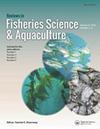Hindcasts and Future Projections of Global Inland and Coastal Nitrogen and Phosphorus Loads Due to Finfish Aquaculture
引用次数: 90
Abstract
A global model is used to calculate feed and nutrient budgets for freshwater and marine omnivorous and carnivorous aquacultural finfish production. The model uses national production data for the period 1970–2010 and the Millennium Ecosystem Assessment scenarios for production and management for 2010–2050. Results indicate that annual nutrient release to the freshwater (1.2 million tonnes of N and 0.1 million tonnes of P in 2010) and marine aquatic environments (0.3 million tonnes of N and 0.05 million tonnes of P) increased less rapidly than fish production, mainly due to improving feed conversion. In the coming five decades, annual nutrient release to freshwater environments may increase to 1.5–2.1 million tonnes of N and 0.1–0.2 million tonnes of P, depending on the production scenario and assumptions on feed conversion and the share of integrated aquacultural production. At present, the global contribution of freshwater aquaculture to nutrient loading of rivers is small. This is the same conclusion reached for the assessment of nutrient export from shellfish aquaculture (Bouwman et al., 2011). However, particularly in Asia, nutrient loading from freshwater fish production and from seaweed and shellfish production is an important factor that should be accounted for when developing models for estimating river nutrient export. Compared to chicken meat and egg production, freshwater aquaculture is a rapidly growing and important cause of the anthropogenic acceleration of the N and P cycles in many parts of the world, and this is especially pronounced in Asia.全球内陆和沿海水产养殖氮磷负荷的预测和未来预测
一个全球模型用于计算淡水和海洋杂食性和肉食性水产养殖鱼类生产的饲料和营养预算。该模型使用1970-2010年的国家生产数据和千年生态系统评估2010-2050年的生产和管理情景。结果表明,淡水(2010年为120万吨N和10万吨P)和海洋水生环境(30万吨N和0.05万吨P)的年养分释放量的增长速度低于鱼类产量,这主要是由于饲料转化率的提高。在未来50年,每年向淡水环境释放的养分可能增加到150万至210万吨氮和10万至20万吨磷,具体取决于生产情景和饲料转化率的假设以及综合水产养殖生产的份额。目前,全球淡水养殖对河流营养负荷的贡献很小。这与贝类养殖的营养输出评估得出的结论相同(Bouwman et al., 2011)。但是,特别是在亚洲,淡水鱼生产以及海藻和贝类生产的营养负荷是在开发估算河流营养输出模型时应考虑的一个重要因素。与鸡肉和鸡蛋生产相比,淡水水产养殖是世界许多地区快速增长和人为加速氮和磷循环的重要原因,这在亚洲尤为明显。
本文章由计算机程序翻译,如有差异,请以英文原文为准。
求助全文
约1分钟内获得全文
求助全文

 求助内容:
求助内容: 应助结果提醒方式:
应助结果提醒方式:


